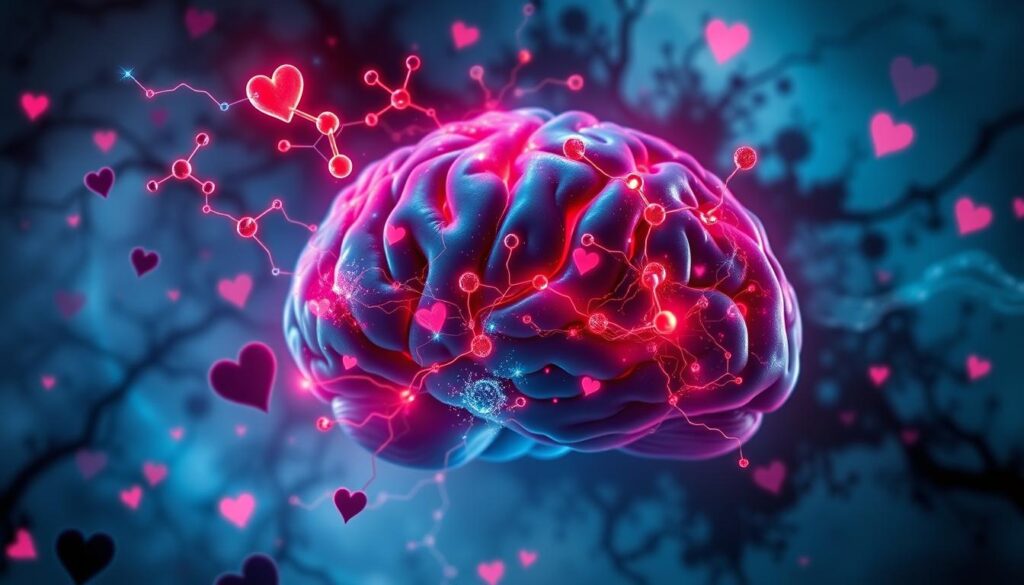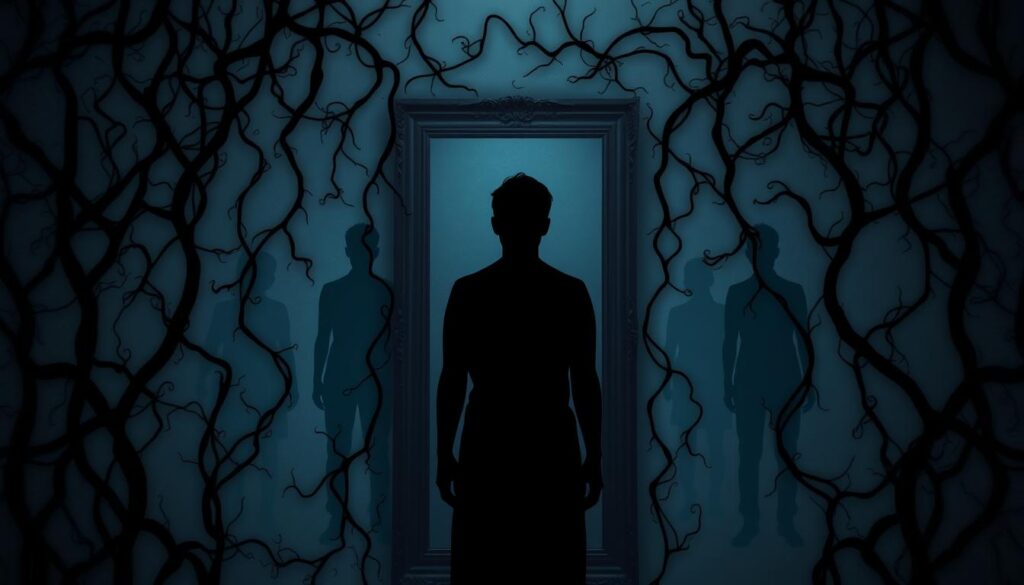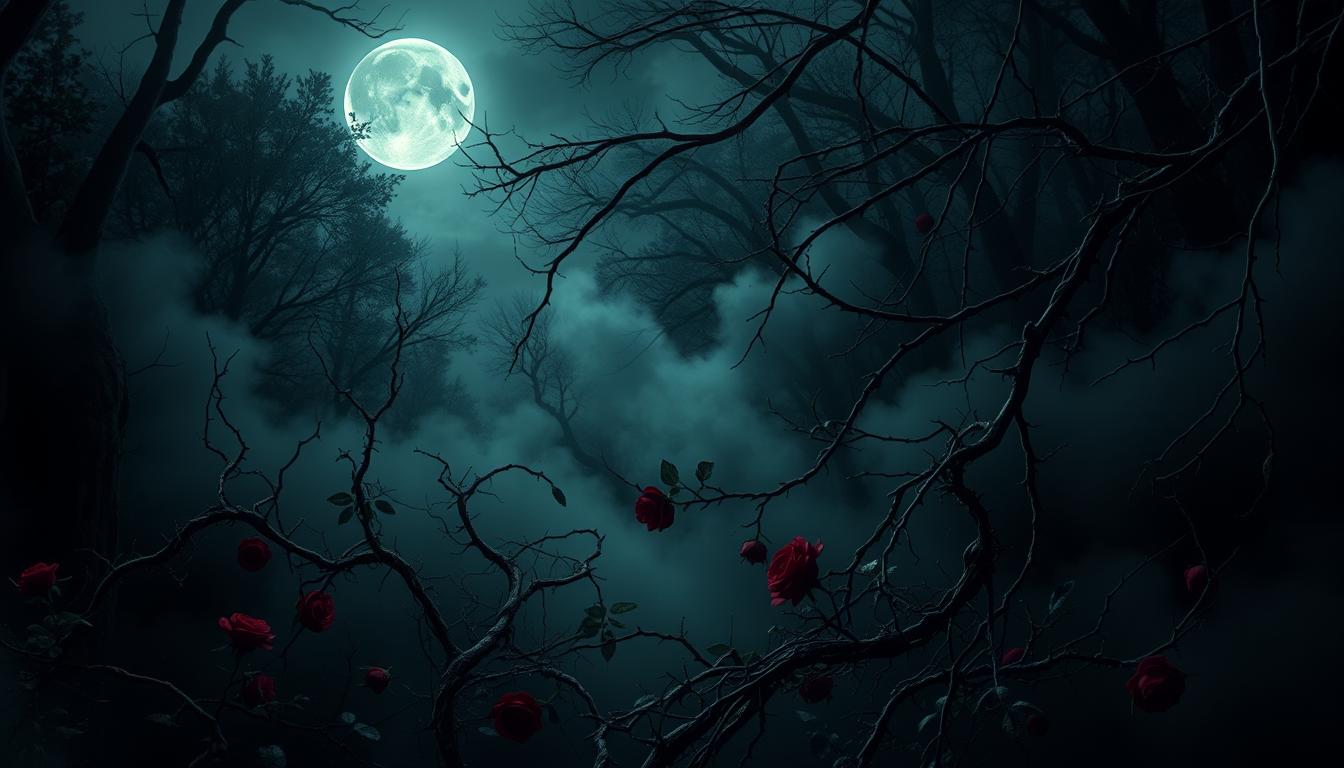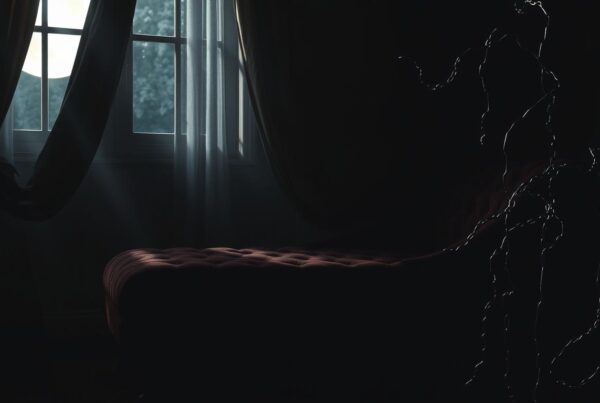Love comes in many forms, but dark romance is especially captivating. These intense relationships have a mysterious allure. They challenge our understanding of attraction psychology. What makes forbidden love so enticing?
Dark romantic relationships ignite fierce passion and deep emotional connections. They push boundaries and test limits, creating excitement and danger. This attraction goes beyond physical chemistry. It taps into our deepest desires and fears.
Exploring the psychology of these complex partnerships reveals many factors. Evolutionary instincts and childhood experiences shape our attraction to dark romance. Let’s dive into the fascinating world of forbidden love and intense relationships.
Understanding Dark Romantic Relationships
Dark romantic relationships are known for their strong attraction and deep love. They often cross boundaries, mixing desire with danger. Let’s dive into the world of taboo romance and see why it’s so appealing.
Defining Dark Romance
Dark romance is about intense feelings, power differences, and risky actions. Partners go through highs and lows. These relationships challenge what society thinks is right, making them exciting.
Common Characteristics
Toxic relationships in dark romance have certain traits. These include jealousy, control, and emotional games. Trust issues and destructive patterns are common. Yet, the strong bond keeps them together.
The Allure of Forbidden Love
The thrill of dark romance is its intensity. The excitement of breaking rules is captivating. For some, the danger makes the relationship more thrilling and special.
Understanding dark romantic relationships is key. The allure is strong, but knowing the risks is important. It helps us see the impact on those involved.
The Role of Evolutionary Psychology in Attraction
Evolutionary psychology helps us understand why we’re drawn to certain people. Our brains, shaped over millions of years, still look for old cues in mates. These instincts often push us towards those who seem genetically right and can protect us.
Finding a mate is more than just love. It’s about survival instincts too. We look for signs of health, fertility, and protection. This is why some are attracted to strength, confidence, or status – qualities that helped in the past.
Genetic compatibility is key in attraction. Research shows we’re drawn to those with different immune systems. This helps in making healthier kids. Our noses can even pick up on genetic differences, adding to that special “chemistry” we feel.
Dark romantic relationships might connect with these ancient attractions. The passion and intensity in these relationships remind us of our ancestors’ mating rituals. While these instincts helped in the past, they can now lead to complex relationships today.
The Influence of Childhood Experiences on Adult Relationships
Childhood shapes our adult relationships deeply. From the start, we form patterns that last a lifetime. These patterns shape how we connect with others and what kind of relationships we look for.
Attachment Styles and Their Impact
Attachment theory shows how early bonds shape adult relationships. Secure attachment leads to good connections. But insecure attachment can make relationships tough.
Children who feel safe and supported usually grow up with secure attachments. This helps them have positive adult relationships.
Parental Relationships as Relationship Models
Our parents’ relationship is our first example of adult love. Kids watch and learn from these examples. They often repeat these patterns in their own relationships.
Parental influence goes beyond just love. It affects how we act with others in many ways.
Trauma and Its Effects on Attraction
Childhood trauma can change how we choose partners as adults. People who faced trauma might seek out unhealthy patterns. This is because they’re drawn to partners who remind them of their past trauma.
Understanding this link is key to better relationships. Therapy and self-reflection can help us see our attachment styles. They can also help us overcome childhood trauma, leading to more fulfilling connections.
The Biochemistry of Attraction in Dark Romance
Dark romance mixes powerful chemicals in our brains. This mix of neurotransmitters and hormones leads to strong feelings and actions. Our brain chemistry is key in these deep connections.

Dopamine, the happy neurotransmitter, spikes during exciting times. It’s what makes us feel alive when we’re with someone thrilling or forbidden. This dopamine rush can make dark relationships feel like an addiction.
Oxytocin, called the “love hormone,” builds strong emotional ties. It’s released during close moments, helping us trust and bond. In dark romances, oxytocin might make us ignore warning signs, keeping us with toxic partners.
The brain’s reward system is super active in these relationships. The ups and downs of dark romance trigger lots of chemical releases. This rollercoaster can be so tempting, making it hard to leave unhealthy relationships.
Knowing how attraction works can help us understand our choices in love. It shows that what feels like an unbreakable bond might just be our brain’s reaction to excitement. Understanding this can help us choose better for our relationships.
The Appeal of the “Bad Boy” or “Femme Fatale” Archetype
The bad boy and femme fatale have always fascinated us. They show us the thrill of taking risks and seeking excitement. Their dangerous charm pulls us in.
Cultural Representations in Media
Pop culture is full of these characters. Think of James Dean or Harley Quinn. They break rules and charm us, keeping us interested.
Psychological Factors Behind the Attraction
People are drawn to these archetypes for excitement and novelty. They might want a break from the usual or a taste of danger. This attraction can be about seeking adventure or rebelling against rules.
The Danger-Excitement Connection
The thrill of danger is a big part of their appeal. It gives us a rush of adrenaline and dopamine. This makes us keep coming back for more, even if it’s risky.
The Psychology of Attraction in Dark Romantic Relationships
Dark romantic relationships draw us in with their strong emotional pull. These connections mix excitement with danger. They tap into deep psychological needs.
Emotional highs and lows are key in dark romances. This rollercoaster of feelings can be addictive. It makes people seek out similar experiences again.
Power struggles are common in these relationships. One person might control while the other submits. This imbalance can feel thrilling but can cause problems later. These issues often come from past traumas or childhood experiences.
Dark relationships can meet hidden psychological needs. Some find drama and conflict exciting. Others seek out unhealthy patterns because they’re familiar. Knowing why we’re drawn to these relationships is important for change.
Understanding the appeal of dark romantic relationships helps us choose better. By meeting our psychological needs in healthy ways, we can find more balanced and fulfilling relationships.
The Role of Power Dynamics in Dark Relationships
Power dynamics are key in dark romantic relationships. They often lead to unhealthy patterns. Knowing about these dynamics helps spot and fix problems in relationships.
Dominance and Submission
In dark relationships, one person is often in charge. This can be due to many reasons like personality or past experiences. The dominant person might control emotions through manipulation. The other might feel unable to change things.
Control and Manipulation
Manipulative relationships use control tactics. These include gaslighting, guilt-tripping, or emotional blackmail. The person in control uses these to keep power over their partner. This can hurt trust and self-esteem, making it hard to leave.
The Psychology of Codependency
Codependency is common in dark relationships. One person relies too much on the other for emotional support. This makes it hard to set healthy boundaries. To break free, it’s important to recognize these patterns and seek help.
The Impact of Low Self-Esteem on Attraction Patterns
Low self-esteem greatly affects our choices in relationships. People with a negative view of themselves often choose partners who make them feel even worse. This search for validation can lead to unhealthy relationships and a cycle of low self-worth.

Those who struggle with self-worth might choose partners who treat them poorly. They believe they don’t deserve better. This behavior confirms their negative self-image, creating a harmful cycle.
For those with low self-esteem, seeking validation is key in their relationship choices. They might choose any attention, even if it’s negative, over being alone. This need for validation can make them overlook warning signs in potential partners, leading to toxic relationships.
To break this cycle, addressing low self-esteem is crucial. Working on self-worth and developing a positive self-image helps make better relationship choices. This journey often involves therapy, self-reflection, and learning to value oneself, regardless of others’ opinions.
The Thrill of the Chase: Pursuit and Elusiveness
The chase in dark romantic relationships is thrilling. Playing hard to get makes attraction intense. It feels rewarding and taps into our primal instincts.
The Allure of Elusiveness
Playing hard to get makes someone more attractive. This elusiveness makes us value what’s hard to get. The chase makes emotions high and exciting, feeling addictive.
Intermittent Reinforcement
Intermittent reinforcement is key in the chase. Unpredictable responses from a partner attract us strongly. This keeps us hooked, always hoping for the next positive interaction.
When Pursuit Turns Unhealthy
The chase can be thrilling but can also be unhealthy. Obsessive pursuit leads to toxic behaviors and emotional distress. It’s vital to keep boundaries and respect in any relationship.
Finding a balance between pursuit and well-being is crucial. The thrill of the chase is exciting but must not harm. Healthy relationships need mutual respect and clear communication, not constant games.
The Role of Physical Attraction in Dark Romance
Physical attraction is very important in dark romantic relationships. The strong pull between partners comes from a mix of sexual chemistry and looks. These factors create a strong attraction that can make people ignore logic and fuel passionate relationships.
In dark romances, looks are very important. Partners are often drawn to each other’s appearance in a primal way. This attraction makes it hard to leave, even when the relationship is bad. The appeal of a partner’s body or face is very strong.
Sexual chemistry is the spark that starts these intense connections. The desire between partners in dark romances is very strong. This makes their interactions addictive. The promise of amazing intimate moments keeps people coming back, even with warning signs.
While looks and lust aren’t all that matters, they are key in dark romantic relationships. The intensity of physical attraction matches the drama and passion in these partnerships. Knowing this helps explain why it’s hard to break free from unhealthy attachments.
Emotional Intensity and Its Addictive Nature
Passionate love brings a storm of emotions. The ups and downs can make you feel addicted. Even when things get bad, you might still want to stay.
The Highs and Lows of Passionate Relationships
Dark romance is all about intense feelings. You might feel extreme joy or deep sadness fast. These feelings make your brain feel like it’s on a drug high.
The Appeal of Emotional Rollercoasters
Many are drawn to the drama in bad relationships. The constant changes keep things exciting. But, this can make you confuse bad behavior for true love.
Passion vs. Toxicity: A Fine Line
Passion is good in love, but it can turn bad. Toxic behavior can look like deep love. It’s important to know the difference to keep your relationship healthy.
The Influence of Past Trauma on Attraction to Dark Relationships
Past trauma can shape our attraction to dark romantic relationships. Trauma bonding happens when intense emotional experiences create a strong bond between people. This bond can form even in unhealthy situations, leading to a cycle of abuse and reconciliation.
Re-enactment is a common subconscious pattern. People unknowingly recreate traumatic experiences in their current relationships. They try to gain control over past events or find closure. Unfortunately, it can lead to choosing partners who mirror abusive figures from one’s past.
Many people believe in healing through relationships. They seek intense connections to mend emotional wounds. This desire can draw them towards turbulent partnerships that promise transformation but often perpetuate harmful patterns. Recognizing these subconscious patterns is crucial for breaking free from destructive relationship cycles.
Understanding the link between past trauma and attraction to dark relationships is key. By addressing underlying issues and seeking professional help, individuals can learn to form relationships based on mutual respect and support. This is instead of trauma-induced bonds.
Cultural and Societal Factors Shaping Dark Romance Attraction
Our society greatly influences how we see dark romantic relationships. Movies and books often show troubled love as exciting. This media shapes our views on love, sometimes without us realizing it.
Media Portrayals of Dark Love
TV shows and films make dark romances seem thrilling and passionate. These stories make us think drama and conflict are normal in love. Popular culture makes troubled relationships seem more appealing than they are.
Societal Norms and Taboos
Every culture has its own ideas about what’s okay in relationships. Some societies see certain behaviors as taboo, while others accept them. These norms can make dark romances seem more attractive or push us away.
The Romanticization of Troubled Relationships
Many myths say love should be intense and full of ups and downs. This idea makes people think calm, stable relationships are boring. But real, healthy love doesn’t need to be a roller coaster ride.



